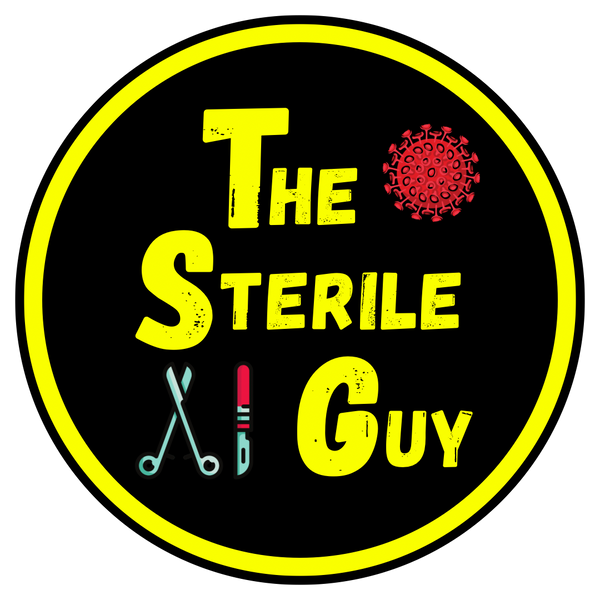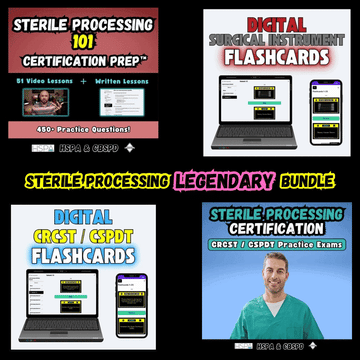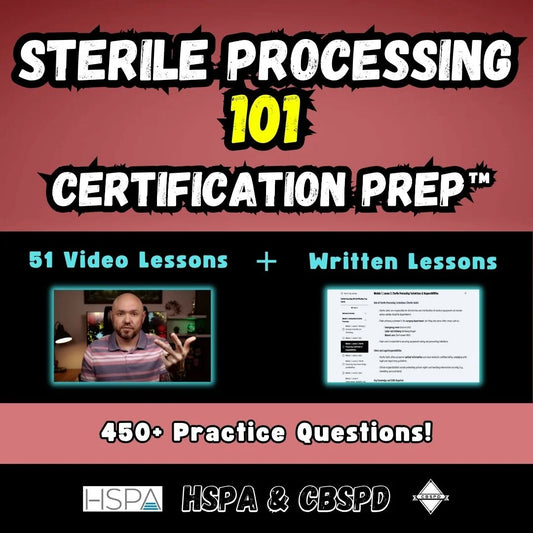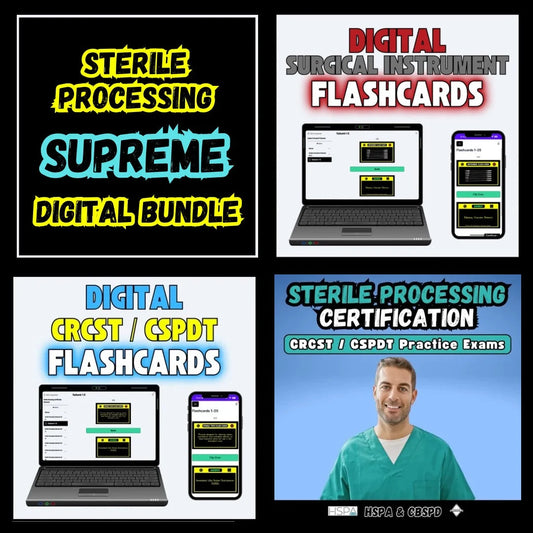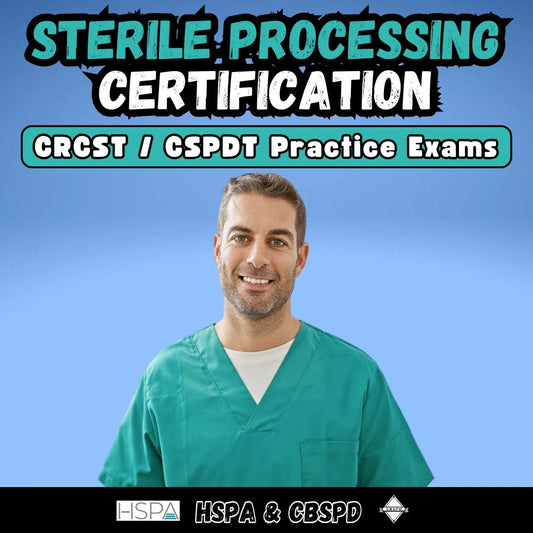Anatomy & Physiology for Sterile Processing Technicians

Sterile Processing Technicians play a vital role in surgical safety. This guide connects anatomy and physiology fundamentals to instrument handling, tray assembly, and sterilization protocols—supporting both clinical precision and patient care.
Introduction to Human Anatomy in Sterile Processing
Why Anatomy Matters
Anatomy helps Sterile Processing staff match instruments to body systems, organize trays efficiently, and understand surgical context.
Key Terminology & Body Planes
- Anterior / Posterior: Front / Back
- Superior / Inferior: Above / Below
- Medial / Lateral: Toward / Away from midline
- Proximal / Distal: Nearer to / Farther from reference point
- Sagittal Plane: Divides left/right
- Frontal (Coronal) Plane: Splits front/back
- Transverse Plane: Divides top/bottom

Musculoskeletal System
Bone Types & Functions
- Support, protection, leverage, mineral storage, hematopoiesis (blood cell formation)
- Long (femur), short (carpals), flat (ribs), irregular (vertebrae), sesamoid (patella)
Muscles & Tendons
- Skeletal (voluntary), smooth (involuntary), cardiac (heart)
- Tendons—common in ACL grafts, fracture repairs, retraction during surgery

Cardiovascular System
Heart & Vessels
- Four-chambered heart with valves—mitral, tricuspid, aortic, pulmonary
- Arteries (oxygenated), veins (deoxygenated), capillaries (exchange sites)
Circulation Paths
Pulmonary: heart ↔ lungs; Systemic: heart ↔ body
Surgical Relevance
Cardiac instrument sets include clamps, retractors, cannulas—sterilization and inspection are critical to prevent infection.

Nervous System
Central & Peripheral Systems
- CNS: brain and spinal cord—controls thought, sensation, movement
- PNS: nerves delivering signals throughout the body
Neurosurgical tools (micro-forceps, dissectors) require precision handling and low‐temperature sterilization.

Respiratory System
Anatomy
Structures: nasal cavity, pharynx, larynx, trachea, bronchi, bronchioles, alveoli
Procedure Connections
Thoracic instruments include bronchoscopes, lung retractors, staplers—require sterility and functional checks (e.g., suction).

Digestive System
GI Structures
Mouth → esophagus → stomach → small/large intestines → rectum → anus; with liver, gallbladder, pancreas.
SPD Focus Areas
Endoscopes and laparoscopic tools demand pre-cleaning, manual brushing, High-level Disinfection (HLD) or sterilization, and drying.

Urogenital System
Urinary & Reproductive Anatomy
Urinary: kidneys, ureters, bladder, urethra. Reproductive: male (testes, prostate, penis) and female (uterus, ovaries).
Instrument Needs
Scopes (cystoscopes, nephroscopes), dilators, speculums—processed with OPA/glutaraldehyde and corrosion prevention.

Integumentary System
Skin, Hair & Nails
- Skin: first infection barrier; no open wounds allowed
- Hair: fully covered to prevent contamination
- Nails: short and clean to avoid compromising gloves

Sensory Organs (Eye & Ear)
Ophthalmic Procedures
Delicate eye tools—micro-forceps, scissors—require low-temperature sterilization and spotless cleaning.
Otologic Procedures
Ear instruments such as speculums and obturators need tip protection, careful inspection, and precise cleaning.

Glossary & SPD Vocabulary
- Anterior / Posterior: Front / Back
- Proximal / Distal: Nearer / Farther from reference point
- Body Planes: Sagittal, Frontal, Transverse
- EO Sterilization: Ethylene Oxide gas-based for heat-sensitive tools
- Gravity Displacement: Air-release steam sterilizer
- Loaner Instruments: Borrowed tools used per-case
Frequently Asked Questions (FAQ)
Why learn anatomy for SPD jobs?
It enables correct tray organization, instrument matching, and sterilization procedures aligned with specific surgeries.
Which body systems need extra focus?
Musculoskeletal, cardiovascular, nervous, respiratory, digestive, urogenital, and sensory systems each correlate with distinct instrument types.
How do body planes affect SPD setup?
Surgeries are oriented based on body planes; SPD labels trays accordingly for intuitive access and positioning.
What's special about sterilizing micro-instruments?
These often require gentle cleaning, and regular sharpness testing.
🎯 Take the free Anatomy & Physiology practice quiz #1 now »
🎯 Take the free Anatomy & Physiology practice quiz #2 now »
Further Resources
Share
Let customers speak for us
from 241 reviewsI took the practice test and I got a 91% on my certification exam!!
This course was the extra boost that I needed in order be confident in passing the exam. Thank you for all the information provided. I even refer to your notes while working.
Very helpful to me I can study any where at my own pace and low cost than going to school...I'm glad that there is something like this online to help anyone who want to pursue their career as a sterile processing tech.
I loved it, it’s very informative and the questions are great, it’s a great resource to purchase if you want to prepare for your certification exam!
I’ve really enjoyed this course so far. It delivers the information in a straightforward, digestible way. The Sterile Guy has compiled a highly effective program. Thanks very much from one highly satisfied customer!
The practice exams are detailed and easy to navigate. Brandon continues to show his passion in this industry by sharing his knowledge with up-and-coming techs. I also recommend investing in his flashcards. It has helped me greatly. Thank you, Brandon!,
These practice quizzes really helped me get the hang of answering questions related to instruments and the processes of preparing them! I even bought them twice cause I ran out of time lol. Super helpful!
I recently completed the Sterile Processing Guy course online and was extremely impressed. The content was clear, well-organized, and easy to follow. It helped me better understand important concepts like decontamination, disinfection, and sterilization. I appreciated how practical and informative the lessons were, it definitely made studying for certification feel more manageable. I highly recommend this course to anyone pursuing a career in sterile processing!
I won’t lie, I failed the first time around. So I decided to buy this practice test and I passed with flying colors my second go. Highly recommend to anyone interested in the CER, it helped a lot!
The flash card quality is amazing! Bravo sir! The card quality is way above average, questions are great! I’m still learning, utilizing these cards and your practice tests. Thanks for all the info!
I passed the CRCST exam. Taking reg sterile guy practice test over and over definitely helped get the job done.
This certification prep course is a must. Great videos with a lot of information and plenty of of practice exams.
These flashcards are so helpful and well put together. Highly recommend!
I'm really happy that I purchased the SP practice exam. I love how if you answer the question incorrectly, the correct answer will include the page number of the text book to find the answer. The questions are literally based on the textbook. I suggested "The Sterile Processing Guy" to my friend that is studying for the exam as well.
